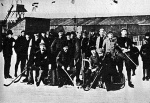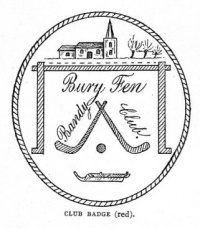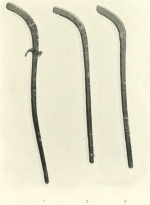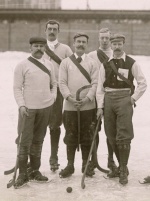Bury Fen Bandy Club
The Bury Fen Bandy Club (also known as the Bluntisham-cum-Earith club and the Bluntisham-cum-Earith Skating Hockey Club) was the most venerable of the early English bandy clubs. The club was situated in the twin villages of Bluntisham and Earith, Cambridgeshire.
History
The origins of the club stretch far back into the annals of history. According to Charles Goodman Tebbutt in Skating (1892), the club had supposedly been unbeaten for a century by the winter of 1813-14, but the first documented matches were only played then.
As told by Tebbutt: "Concurrently with skating races, bandy matches have long been held in the fens. It is certain that during the last century the game was played and even matches were held on Bury Fen, and the local tradition that the Bury Fenners had not been defeated for a century may not be an idle boast. But it was not until the great frost of 1813-14 that tradition gives place to certainty. I propose to furnish a short account of the Bury Fen players; for, excepting a few games played on private waters in different parts of England, bandy has been confined to that district, and its history is a history of the game.

When the army of Napoleon, retreating from Moscow [this was actually the winter of 1812- 1813], were starved and frozen to death by thousands; when, at home, Prof. Sedgwick had to burn his gun-case and chairs to keep himself warm; when the scarcity of coal at Cambridge was so great that the trees within the grounds of St. John's College were cut down for fuel, and in all the colleges, we are told, the men sat in their rooms two and three together for warmth; then the hardy watermen, gunners, and labourers were quickening their circulation by playing bandy on Bury Fen. It was then that that fine old Fenman, William Leeland, at the time scarcely eleven years old, remembers watching the matches and joining in the practice of bandy. Undoubtedly matches were played before this time, and Leeland had 'heard talk' of them; but we have no records…"
"[From about 1825] until well into 1850 Leeland captained the Bury Fenners, and only died in the autumn of 1891, in his ninetieth year [actually in his 87th]. An interview with this fine old player was made specially interesting by his pleasant memories of matches won at bandy..."
"[Of the players from the early part of the century] "only Mr. R. Brown (88), Jas. Searle (75), and Bill Christmas (71), still live at the time of writing (Christmas, 1891)…"
Another quote from Charles Goodman Tebbutt, from an article written in The Sports World in 1895: "For almost centuries this fen district has been noted for bandy, and the fen villages and River Ouse towns of Cottenham, Willingham, Chatteris, Mepal, Swavesey, St. Ives, Huntingdon, and Godmanchester have met in friendly contests; but the centre and home of play has always been Bury Fen, and the ambition of all has been to defeat the twin villages. Most of these places have, by the improving hand of the drainer, lost their flooded wash; Bury Fen and Swavesey Mere Fen alone remain. Records of matches played on Bury Fen date back for a century, whilst tradition goes back much further; and so skilled were its players - consisting of farmers, gunners, lightermen, and tradesmen - that it is claimed, with much reason, that for a century they did not know defeat."
The club used a ball and curved sticks, with fen runners as their skates. They liked to play on expansive ice surfaces found in the Fens. The Bury Fen club maintained their credit of an unbeaten record until 1891, when they left their home turf (ice?) for the time to face the Virginia Water Hockey Club. The two clubs had contrasting playing styles (the Londoners traditionally played with ash sticks and a bung) and the match led to the formation of the National Bandy Association several weeks later.
The Tebbutt Family and the Goodmans (who were closely related to the Tebbutts) were undoubtedly the driving forces behind the club. After William Leeland's longtime captaincy had ended, Charles Prentice Tebbutt and Neville Goodman were captains of the team.
Charles Prentice had five sons, all of whom took up playing bandy themselves. Neville, Arnold, and Charles Goodman were all particularly enthusiastic in their promotion of the sport.
The Bury Fen club went on tours of the Netherlands in 1891 and 1893, and later visited Germany in 1899. Meanwhile the sport of bandy was experiencing a surge of popularity during the 1890s, and many matches were played in the Fens.
Outdoor bandy experienced a quick death however, and the Bury Fen club shut down sometime around 1901. A combination of milder winters preventing play and the opening of indoor rinks where bandy/hockey could be played spelled doom for the outdoor sport, and with it, the tradition-rich Bury Fen club.


